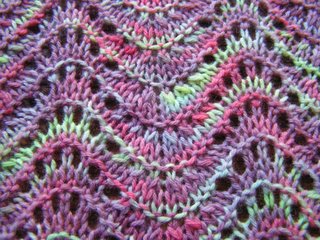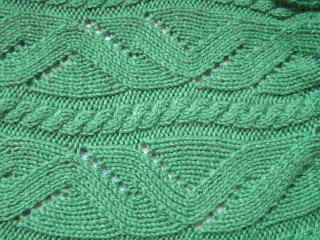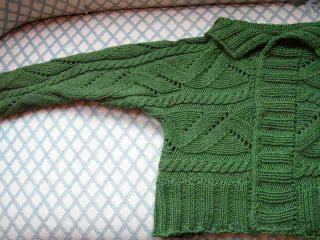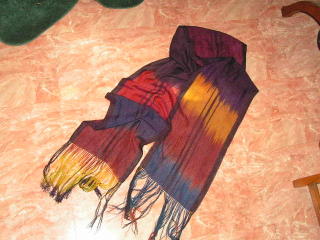Rejection


Rejected by Knitty, but I still think I have a cool scarf, so here, you can still have it for free!
Pattern name: Punch
SIZE: You
FINISHED MEASUREMENTS:
Length: 6 feet
Width : 8 inches
MATERIALS: [MC] Knit Picks Paint Your Own [100% Merino Wool; 880 yards per 100 gram skein]; Natural white; 1 skein, or as many yards of a fingering-weight yarn.
1 set US # 6 needles/4 mm straight or circular needles,
Tapestry needle,
Between 9 and 12 packets of Kool-Aid Unsweetened Soft Drink Mix,
Thermometer,
Large pan
GAUGE: 20 sts/ 24 rows = 4 inches in stockinette stitch. Exact gauge is not critical for this project.
DYE DIRECTIONS: Kool-Aid comes in so many colors that you can mix flavors and create just about any color you desire. In choosing a palate there are a few things to keep in mind. It is always easier to rip-off nature than to derive your own color way. Observe your surroundings, and choose three or four colors that look good together. A color wheel is never a bad investment. When hand painting yarn you must remember that the colors you choose will blend together where they intersect, and form yet another color, so choose a palate that will produce nice secondary colors. For example, purple and green go well together, but they can produce muck when they intersect, so understand that you must either ensure that none of the colors run into each other, or you must place an intermediary color (such as light blue in this case) that results in a pleasing secondary color. Don’t shy away from leaving some of the skein white! One of the advantages with painting your own yarn is that you can have a palate that is not already available. Hand painted yarns so seldomly feature white, that leaving a little in can make your skein look down right exotic! Consider an unbalanced placement of colors. In this scarf, I used only a small amount of green compared to the purple and reddish-purple. Finally, if you choose a good basic palate with complimentary colors, then you are unlikely to end up with a disaster; frequently a semi-disastrous looking skein will actually knit up into something pleasing. A real disaster will not seem so when felted into something.
Take the skein and submerge it in a large pot of water for a day. To take dye evenly, wool must be well saturated. The yarn will swell up a lot as it absorbs water. That’s a good thing.
Choose two or more packets of three-to-four flavors of Kool-Aid drink mix. Choose only one color if you wish, but you will need about nine to twelve packets for one skein depending on how saturated you want the colors to be. Dissolve the drink mix in about a cup of water, and blot some on a piece of paper towel to test colors, and see how the secondary colors look. Now is when you blend colors, dilute with water, or add more drink mix until you have color solutions you like.
Once the yarn is completely saturated, prepare the dye bath by taking a large pot and filling it with several inches (or two and a half as many centimeters if you live far north) of water. Add a “glug” or two of white vinegar. Temperature and acidity are essential to successful dyeing. If your dye bath is too acidic, the dye will strike the spot where you poor the dye instead of spreading out over the skein. I actually like that because I find color placement easier to control. If your dye bath is not acidic enough, the color will not take to the dye. About one “glug” per four cups of water is a good rule of thumb. Place the skein in the solution and slowly heat to 190º fahrenheit, being careful not to agitate the skein too much. Using a large spoon, press any air bubbles out of the skein that build up during the heating process. You are ready to add the dye! Pour the dye onto the skein placing different colors on different sections of the yarn. The dye will exhaust within about five minutes. Allow one color to exhaust before adding the next color. This is indicated by the dye bath becoming completely clear as the dye is absorbed into the yarn. As the dye is exhausting, keep the temperature as constant as possible. Use a fork to lift, or pry open parts of the skein and make sure dye has reached all parts of the yarn. When you are finished adding dye, allow the skein to simmer for about ten minutes, keeping the temperature as constant as possible. Remove the pan from the heat source, and carefully remove the yarn from the water, being careful as the water is extremely hot. Gently ring out the skein, washing it if you desire, and ring as much water from the yarn as possible without agitating the yarn, as that can result in felting. Laugh out loud because your yarn smells like fruit punch. Hang the skein to dry, and marvel at your talent!
PATTERN: CO 46 sts.
K 4 rows slipping first st as if to purl. Make sure that the slipped st at the beginning of each row is very loose throughout the work.
Row 1 [RS]: Sl first st as if to purl, K4, [K2tog] three times, [Yo, K1] six times, [sl 1, K1, psso] three times, [K2tog] three times, [Yo, K1] six times, [Sl 1, K1, psso] three times, K5, turn.
Row 2 [WS]: Sl first st as if to purl, K to end, turn.
Row 3 [RS]: Sl first st as if to purl, K to end, turn.
Row 4 [WS]: Sl first st as if to purl, P to end, turn.
Repeat Rows 1-4 until you have used up most of your skein ending on row 4. K4 rows, slipping first st as if to purl, BO loosely.
FINISHING:
Sew in ends. Gently wash scarf in warm water, and block it within an inch of its life. If you needed a reason to invest in blocking wires, this is it. Otherwise, weave your smallest gauge, longest circular knitting needles through the edges of the scarf between the slipped edge stitches and the rest of the work. Stretch out the scarf and pin using the circular needles as blocking wires. Proudly wear or gift scarf.














